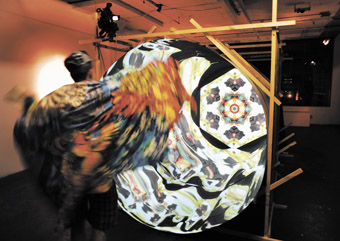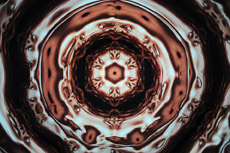the real thing
 |
Jordana Maisie |
like a wheel within a wheelWhen you peer into a kaleidoscope, into the mirrored surfaces on which tiny fragments of coloured glass spark and rattle, and raise the toy against the light, you don’t expect to see yourself. But in Sydney artist Jordana Maisie’s The RealThing, that’s what you get, the real you, captured by video and fragmented by soft and hardware magic into an infinite number of glorious mandalas. Significantly Maisie’s work is on a human scale. The large screen facing you is contained in a deep circle of thin, bright metal, a camera hanging discreetly just above. Your actions become experimental as soon as you realise that the patterning on the vivid screen is evolving at the same rate as your own movement. You adjust relative to the camera. You discover that you can position hands, face, torso, objects with astonishing results, as surreal, temporary still lives or slow, lyrical dances. Instead of the way you’d hold a kaleidoscope, in the Real Thing it’s the way you hold yourself, and far more interesting than, say, the fairground’s distorting mirrors. Here, Jordana Maisie the maker turns us into co-maker and subject at once. But it’s no mere narcissistic delight, because there’s no coherent mirroring of the self. Rather, we’re offered the perverse pleasure of dissolving and rearranging ourselves. Jordana Maisie, The Real Thing, sculpture, interactive video installation, Black & Blue Gallery, Sydney, Aug 29-Sept 14; www.blackandbluegallery.com.au |
 |
Jordana Maisie"One of my key concerns is the way digital technologies remediate physical space. The kaleidoscope is a long-standing mainstream optical illusion. Taking the 'desktop' of a computer interface as inspiration I chose to resize and remediate the kaleidoscope and by doing so, make reference to the optical illusion that is the 'digital/virtual' world. This work is a continued exploration into a current shift in sensory experience which is catalysed by technological development. How is the way we move through and interact with space changing as a result of increasingly well integrated screen-based digital cultures? |








 back
back